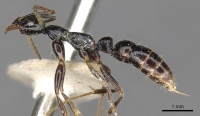Leptogenys harmsi
| Leptogenys harmsi | |
|---|---|

| |
| Scientific classification | |
| Kingdom: | Animalia |
| Phylum: | Arthropoda |
| Class: | Insecta |
| Order: | Hymenoptera |
| Family: | Formicidae |
| Subfamily: | Ponerinae |
| Tribe: | Ponerini |
| Genus: | Leptogenys |
| Species: | L. harmsi |
| Binomial name | |
| Leptogenys harmsi Donisthorpe, 1935 | |
Identification
Distribution
Distribution based on Regional Taxon Lists
Indo-Australian Region: Christmas Island (type locality).
Distribution based on AntMaps
Distribution based on AntWeb specimens
Check data from AntWeb
Countries Occupied
| Number of countries occupied by this species based on AntWiki Regional Taxon Lists. In general, fewer countries occupied indicates a narrower range, while more countries indicates a more widespread species. |

|
Estimated Abundance
| Relative abundance based on number of AntMaps records per species (this species within the purple bar). Fewer records (to the left) indicates a less abundant/encountered species while more records (to the right) indicates more abundant/encountered species. |

|
Biology
Castes
Images from AntWeb

| |
| Syntype of Leptogenys harmsi. Worker. Specimen code casent0902619. Photographer Z. Lieberman, uploaded by California Academy of Sciences. | Owned by NHMUK, London, UK. |
Nomenclature
The following information is derived from Barry Bolton's Online Catalogue of the Ants of the World.
- harmsi. Leptogenys (Lobopelta) harmsi Donisthorpe, 1935: 631 (w.m.) CHRISTMAS I.
Description
References
References based on Global Ant Biodiversity Informatics
- Donisthorpe, Horace. 1935. The Ants of Christmas Island. Annals and Magazine of Natural History. 25:629-635.
- Donisthorpe, Horace. 1935. The Ants of Christmas Island. Annals and Magazine of Natural History. Ser. 10: xv. 629-635.
- Framenau V.W., and M.L. Thomas. 2008. Ants of Christmas Island (Indian Ocean); identification and distribution. Records of the Western Australian Museum 25: 45-85.

